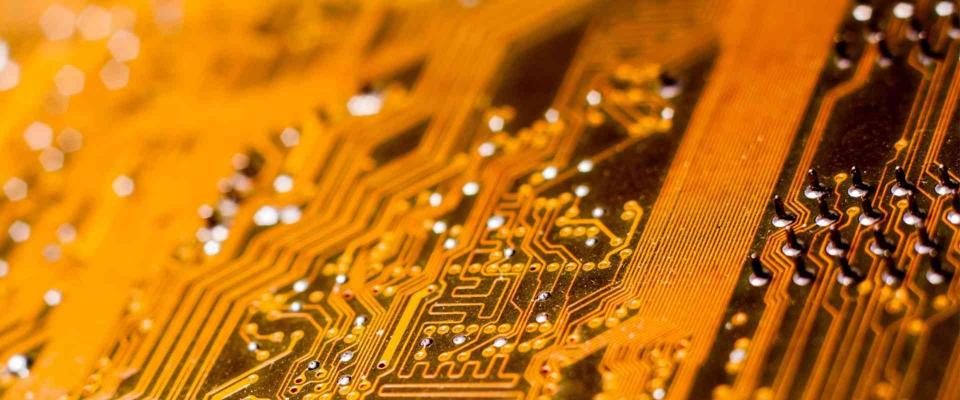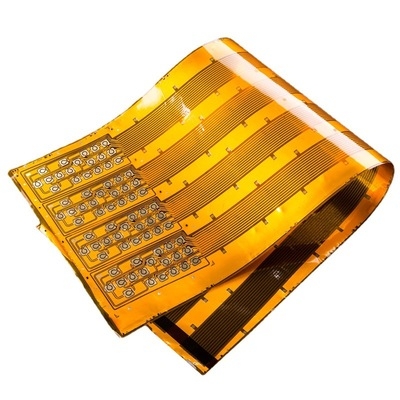Flex circuits, integral to modern electronics, facilitate the creation of devices that are more versatile, lightweight, and compact. Single-sided copper flex circuits are particularly noteworthy for their straightforward design and practicality. These circuits feature a single layer of copper trace adhered to a polyimide substrate, with a polyimide overlay exposing the copper on one side only. This differs from dual-access circuits, which permit connectivity from both top and bottom sides. The simplicity of single-sided flex circuits makes them indispensable in electronic designs prioritizing space efficiency and streamlined construction, underscoring their pivotal role in technological innovation.

What are Copper Flex Circuits?
Definition and Basic Structure of Flex Circuits
Copper flex circuits, commonly referred to as flexible printed circuits (FPCs), feature a single layer of copper trace. Due to their singular copper layer, these circuits are also known as 1-layer flexible printed circuits, or simply 1L FPC. They represent the most straightforward and historically popular configuration of flexible circuit boards. The minimal thickness of the 1-layer FPC not only ensures maximal flexibility compared to other types of FPCs but also illustrates why many have shifted from rigid boards to flexible ones. This flexibility is crucial for applications requiring tight bending capabilities without compromising circuit integrity.
Advantages of Flex Circuits Over Traditional PCBs
One significant advantage of single-sided flex circuits is their ultra-thin construction, with thicknesses as low as 0.06mm achievable by manufacturers like Best Technology. This thinness allows for lighter, more compact electronic designs, reducing the overall size and weight of devices. Flex circuits also offer enhanced reliability under dynamic and high-flex conditions, making them ideal for advanced electronic applications where traditional rigid printed circuit boards (PCBs) would be too bulky or fragile.
Introduction to Single-Sided Flex Circuits and Their Specific Characteristics
Single-sided flex circuits are characterized by having all their electrical components and connections on one side of the flexible board. This layout simplifies the assembly process and reduces the complexity and cost of the board. It is particularly beneficial for applications that require a simple circuit with high flexibility and where space and weight are critical considerations. Their design adaptability allows them to be folded or creased into small spaces, making them indispensable in modern electronic devices.
Applications of Single-Sided Copper Flex Circuits
Overview of Industries Benefiting from Single-Sided Flex Circuits
The unique properties of single-sided flex circuits have made them invaluable across various industries. Their ability to conform to different shapes and their lightweight nature makes them especially useful in consumer electronics, automotive, medical, and aerospace sectors. These industries benefit from the circuit's ability to integrate into tight and mechanically demanding environments typical of modern compact and portable devices.
Examples of Applications
Single-sided flex circuits find their applications in numerous high-tech devices, enhancing functionality while adhering to stringent space and weight limitations. For instance:
- Optical Pick-up for Audio/Video & Computers: Essential in devices like CD and DVD players for precise data reading.
- Digital Cameras and Camcorders: Utilized in capstan motors that drive the tape or film transport mechanism.
- Mobile Phones: Used in vibration motors, providing the tactile feedback essential for user interaction.
- Printers and Robotics: Flex circuits are employed in moving print heads and robotic arms, respectively, where their flexibility allows for efficient and reliable movement.
- Medical Devices: Their application in compact medical devices, like wearable monitors, demonstrates their crucial role in medical technology where flexibility and reliability are paramount.
In each of these applications, single-sided flex circuits provide crucial technological advantages that facilitate the development of more efficient, reliable, and compact devices, driving innovation across numerous fields.
Design Considerations and Challenges
Unique Design Factors of Single-Sided Flex Circuits
Designing single-sided flex circuits necessitates a specialized approach due to their distinctive physical attributes. With all components and conductive traces located on one side, designers must optimize space utilization while maintaining robust circuit functionality. Thermal management poses a critical challenge as the single-layer construction must efficiently dissipate heat without additional layers for assistance. Moreover, flexibility requirements must be meticulously balanced to ensure the circuit meets performance expectations without compromising integrity or functionality.

Addressing Challenges
Single-sided flex circuits encounter significant challenges impacting their design and application effectiveness. The bending radius is crucial—a too-tight radius risks copper cracking and potential circuit failure. Durability is another concern, especially in environments subject to frequent flexing or harsh conditions. Signal integrity is susceptible to improper layout and external interferences, particularly in compact configurations where trace proximity increases the risk of crosstalk and electromagnetic interference.
Critical Role of Material Selection
Material selection profoundly influences the performance and reliability of single-sided flex circuits. Balancing copper thickness against flexibility needs is crucial—thicker copper offers lower resistance but may compromise flexibility. Substrate materials, such as polyimide renowned for its excellent thermal and chemical resistance, are chosen based on thermal stability, mechanical durability, and dielectric properties. These choices are pivotal in ensuring the circuit meets stringent operational requirements across diverse applications.
Manufacturing and Assembly Techniques
Manufacturing Processes for Single-Sided Flex Circuits
The production of single-sided flex circuits involves intricate procedures beginning with the creation of a conductive copper layer on a flexible polyimide film. Photoimaging defines the circuit pattern, followed by etching to remove excess copper and form desired traces. Additional processes like drilling and plating are employed for vias if required. The final step involves applying a protective coverlay or solder mask to provide insulation and safeguard against environmental factors, ensuring long-term reliability.
Precision Assembly Techniques and Considerations
Assembly of single-sided flex circuits demands meticulous attention to component placement and soldering techniques. Given their flexibility, traditional soldering methods may pose challenges, prompting the use of techniques like hot bar soldering to prevent substrate damage. Careful consideration of strain relief features is essential to mitigate stress on components and solder joints during flexing, enhancing overall durability and performance reliability.
Rigorous Quality Control Measures and Testing Methods
Maintaining stringent quality control throughout the manufacturing process is paramount to guaranteeing the reliability and performance of single-sided flex circuits. Comprehensive visual inspections, electrical testing, and mechanical assessments, including bend endurance testing, are standard practices. Advanced methodologies like Time Domain Reflectometry (TDR) are employed to assess signal integrity, identifying and rectifying potential defects early in the production cycle to ensure superior product quality.
Future Trends and Innovations
Emerging Trends Shaping Single-Sided Flex Circuits
Future trends in single-sided flex circuits emphasize advancing integration and complexity while enhancing flexibility and durability. There is a notable shift towards sustainable materials and manufacturing processes, reflecting broader industry initiatives. Innovations in simulation and design software are facilitating more precise circuit designs, optimizing performance and operational efficiency across diverse applications.
Innovations in Materials and Manufacturing Techniques
Recent advancements include novel substrate materials offering enhanced thermal management and mechanical strength characteristics. Evolving manufacturing techniques, such as laser processing and additive manufacturing, are enabling more intricate and flexible production capabilities, pushing the boundaries of what's achievable in circuit design and application.
Potential Applications and Market Growth
The future holds promising prospects for single-sided flex circuits, with anticipated growth in sectors like wearable technology, medical devices, and flexible electronics. Increased adoption in automotive and aerospace industries is also projected due to demand for lightweight, durable components. As technological advancements continue, expanding applications and evolving market dynamics are expected to drive ongoing innovations and market expansion in the field of single-sided flex circuits.
Closing Words
Single-sided flex circuits stand at the forefront of electronic component evolution, characterized by unique design considerations, intricate manufacturing processes, and expansive application potential. As industries increasingly seek compact, flexible, and durable electronic solutions, these circuits are poised to fulfill pivotal roles. Ongoing advancements in materials and manufacturing techniques not only bolster their performance and reliability but also foster sustainable practices in electronics manufacturing. With emerging trends emphasizing integration and environmental stewardship, alongside innovations expanding flexibility and complexity, single-sided flex circuits are primed for substantial growth across diverse sectors. The future holds promise for these versatile components, poised to innovate applications across wearable tech, medical devices, automotive, and aerospace industries, driving the next wave of electronic design and functionality forward.










 2024-06-17
2024-06-17
 BEST
BEST

.png)
.png)
.png)
.png)

.png)

